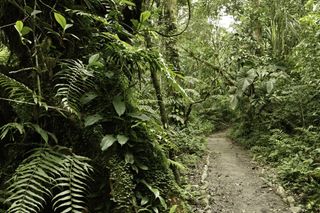
Unique Andes Species Lack Protection, Study Finds

Data collected over the last 100 years by explorers of the Andes, combined with satellite images of the Andes-Amazon basin of Peru and Bolivia, show that many of the species unique to the area lack vital national-level protection, a new study concludes.
"Conservation across the Andes needs urgent revising, and we hope that our data will help protect this incredibly unique region," study researcher Jennifer Swenson of Duke University said in a statement.
To locate the geographic distributions of species and ecosystems in the Andes-Amazon basin, a multinational team, including researchers from the United States, Bolivia and Peru, analyzed the biodiversity of approximately 800 endemic species.
Endemic species, or species that are restricted to a specific area and do not live anywhere else, are an ideal indicator for measuring biodiversity. The researchers looked at more than 7,000 individual records of endemic species locations for 115 birds, 55 mammals, 177 amphibians and 435 plants.
The researchers then created species-distribution maps by comparing the species statistics to a combination of environmental information, including digital topography data from NASA's Shuttle Radar Topography Mission, vegetation images taken by NASA's MODIS satellite sensor and climate data.
Using the species and geographical information, researchers mapped a wide range of ecosystems in Bolivia and Peru, including the wetlands of the Beni savanna, the dry Interandean valleys and the cool, humid forests along the eastern Andean slope. [Journey Into the Tropical Andes]
Their findings showed that one of the areas with the highest levels of species and ecosystems "irreplaceability," as well as the highest number of birds and mammal species, is an unprotected region surrounding Machu Picchu, a World Heritage site located in Cordillera de Vilcabamba, Peru.
Sign up for the Live Science daily newsletter now
Get the world’s most fascinating discoveries delivered straight to your inbox.
The findings showed the highest concentration of endemic birds and mammals along a narrow band of the Andes Mountains, located between 8,200 feet (2,500 meters) and 9,840 feet (3,000 m) above sea level. Endemic amphibian species peaked at 3,280 feet to 4,920 feet (1,000 m to 1,500 m) and were concentrated in southern Peru and northern Bolivia.
The researchers also found that a total of 226 species endemic to the Andes-Amazon basin of Peru and Bolivia have no national protection, while about half of the ecological systems have 10 percent or less of their range protected.
Additionally, only 20 percent of the areas with high numbers of endemic species and 20 percent of the irreplaceable areas are currently protected, according to the findings. The researchers suggest that new protected areas are needed to safeguard endemic species and ecosystems in order to preserve biodiversity.
"Biodiversity in the Andes is under threat from oil and gold mining, infrastructure projects, illegal crops and many other activities," Swenson said.
Climate change also poses a challenge, the researchers wrote in the study, because it may cause the ranges of various species to shift across the landscape and possibly out of protected areas.
"There is already evidence of species migrating upslope to keep up with climate change in this region," Swenson said.
The study was published Jan. 27 in the journal BMC Ecology.
This story was provided by OurAmazingPlanet, a sister site to LiveScience. You can follow LiveScience writer Remy Melina on Twitter @remymelina. Follow LiveScience for the latest in science news and discoveries on Twitter @livescience and on Facebook.
Most Popular

